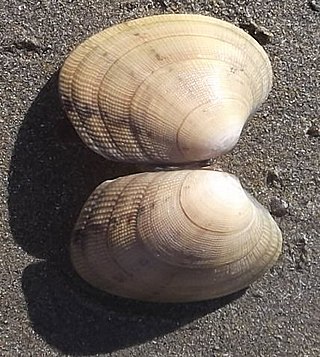
The Gulf of Cádiz is the arm of the Atlantic Ocean between Cabo de Santa Maria, the southernmost point of mainland Portugal and Cape Trafalgar at the western end of the Strait of Gibraltar. Two major rivers, the Guadalquivir and the Guadiana, as well as smaller rivers, like the Odiel, the Tinto, and the Guadalete, reach the ocean here.

Solemyidae is a family of saltwater clams, marine protobranch bivalve mollusks in the order Solemyida.

Mya truncata, common name the blunt gaper or truncate softshell, is a species of edible saltwater clam, a marine bivalve mollusk in the family Myidae.

Petricolaria pholadiformis, common names false angelwing, or false angel wing (US), and American piddock (UK), is a species of saltwater clam, a marine bivalve mollusk in the family Veneridae, the Venus clams.
Vulcanocalliax arutyunovi is a species of Thalassinidea found on a mud volcano in the Gulf of Cádiz between Spain and Morocco. It was discovered during the Census of Marine Life, and is so distinct from its closest relatives that it has been placed in a new subfamily, the Vulcanocallianacinae. The species is unusually large for a ghost shrimp, but despite that appears to brood only a single embryo. The species is named after the volcano on which it was discovered, Captain Arutyunov.
Solemya borealis, the boreal awning clam, is a species of saltwater clam, a marine bivalve mollusc in the family Solemyidae the awning clams. This species is found along the northeastern coast of North America, from Nova Scotia to Connecticut.
Solemya occidentalis, the West Indian awning clam, is a species of marine bivalve mollusc in the family Solemyidae. This species is found in the western Atlantic Ocean from Florida to the West Indies.
Solemya velum, the Atlantic awning clam, is a species of marine bivalve mollusc in the family Solemyidae, the awning clams. This species is found along the eastern coast of North America, from Nova Scotia to Florida and inhabits subtidal sediments with high organic matter (OM) content and low Oxygen, such as salt ponds, salt marshes, and sewage outfalls.

Isognomon alatus, the flat tree oyster, is a species of bivalve mollusc in the family Isognomonidae. It can be found along the Atlantic coast of North America, ranging from southern Florida to Brazil and Bermuda.

Pteria colymbus, the Atlantic winged oyster, is a species of bivalve mollusc in the family Pteriidae. It can be found along the Atlantic coast of North America, ranging from North Carolina to Bermuda and Brazil.

Pinna carnea, commonly called the amber pen shell, is a species of bivalve mollusc in the family Pinnidae.
Phaxas pellucidus, the transparent razor shell, is a species of marine bivalve mollusc in the family Pharidae. It is found buried in the seabed in coastal waters of northwest Europe, often in great numbers.

Venerupis decussata is a marine bivalve mollusc in the family Veneridae, commonly known as the cross-cut carpet shell.

Cyrtopleura costata, or the angel wing clam, is a bivalve mollusc in the family Pholadidae. It is found in shallow parts of the northwest Atlantic and also in the North Sea of Scotland coastline and west coast of the Adriatic Sea by a remote area in the Marche region in central Italy, living in the seabed, where it digs its burrows on a very slow revolving movement for years through soft sand and mud always to a max depth of 8ft but always below 3 feet (0.91 m) at the lowest tide.

Mulinia lateralis, the dwarf surf clam or coot clam, is a species of small saltwater clam, a bivalve mollusc in the family Mactridae. It occurs in the western Atlantic Ocean and the Caribbean Sea.

Venerupis corrugata, the pullet carpet shell, is a species of bivalve mollusc in the family Veneridae. It is found buried in the sediment on the sea bed in shallow parts of the eastern Atlantic Ocean. It is harvested for human consumption in Spain and other parts of Western Europe.

Glossus humanus, the oxheart clam, is a species of species of marine clam found in deepwater off the Atlantic coastline of Europe and Northern Africa. It is the only remaining extant species in the genus Glossus.

Dinocardium is a genus of large saltwater clams or cockles, marine bivalve molluscs in the family Cardiidae, the cockles. There is only one species in the genus, Dinocardium robustum, or the Atlantic giant cockle.

Solemya is a genus of saltwater clams, marine bivalve mollusks in the family Solemyidae, the awning clams. Solemya is the type genus of the family Solemyidae.

Pharus legumen, is a species of bivalve mollusc commonly found burrowed in the sand on lower shores and in the shallow sublittoral.















